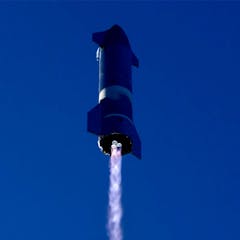
Articles on SpaceX
Displaying 41 - 60 of 132 articles

Billionaires Jeff Bezos and Elon Musk are in a space race, but their endeavours reflect a colonial mentality. This comes at the expense of finding solutions for our current environmental challenges.

According to a new poll, people across political and demographic lines think the private space race is good for the future but still just an ego trip for the billionaires involved.

Sir Richard Branson’s successful spaceflight marks the beginning of a new chapter for space tourism.

In the coming decades, governments and private companies will set up permanent bases on the Moon and Mars. And at some point, the first galactic baby will be born.

Biak inhabitants fear a new space project of Elon Musk, if it goes ahead, will damage their environment, cultures and livelihoods, and potentially displace local communities.

The first space tourist left Earth 20 years ago aboard a Russian rocket. Now, private companies like Jeff Bezos’ Blue Origin are offering trips to the stars for those who can pay.

The first space tourist left Earth 20 years ago aboard a Russian rocket. Now, private companies are on the cusp of offering trips off Earth for those who can pay.

Exercise is important for astronauts to prevent weak muscles.

Earth orbit is filling up with satellites and space junk. Technological fixes can only go so far to deal with the problem.

Space mining might be closer than you think. But legal issues about the ownership of space resources must be urgently addressed to avoid space wars over natural resources.

The space laws designed to protect planets and moons from contamination.

SpaceX is due to test fly its Starship in the coming days.

The shift toward mega-constellations is a challenge for global space governance.

Who cares what happens to bootprints on the Moon? All humans should. And thankfully the US Congress and president agree.

We’ve already sent probes to land on Mars. The challenge now is to get people there and bring them home again.

Over the coming decade, the arrival of constellations of small satellites will reshape the space industry. It constitutes a paradigm shift, particularly in terms of data gathering and processing.

Starship’s groundbreaking design will help it land safely on Mars one day.

SpaceX’s satellites will populate the night sky, affecting how we observe the stars. And this is just the beginning of private satellite mega-constellations.

Humans have been living on the International Space Station for two full decades. So what comes next for this ailing technology, and what does it mean for future International ventures in space?

Radio telescopes are incredibly sensitive to phone network interference.
